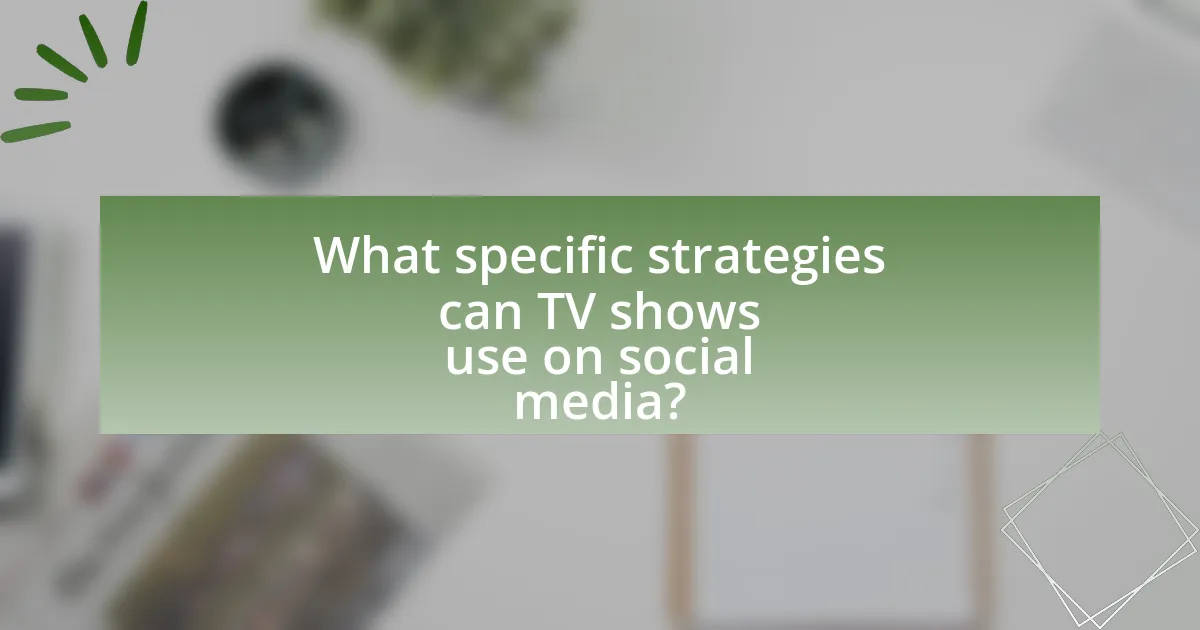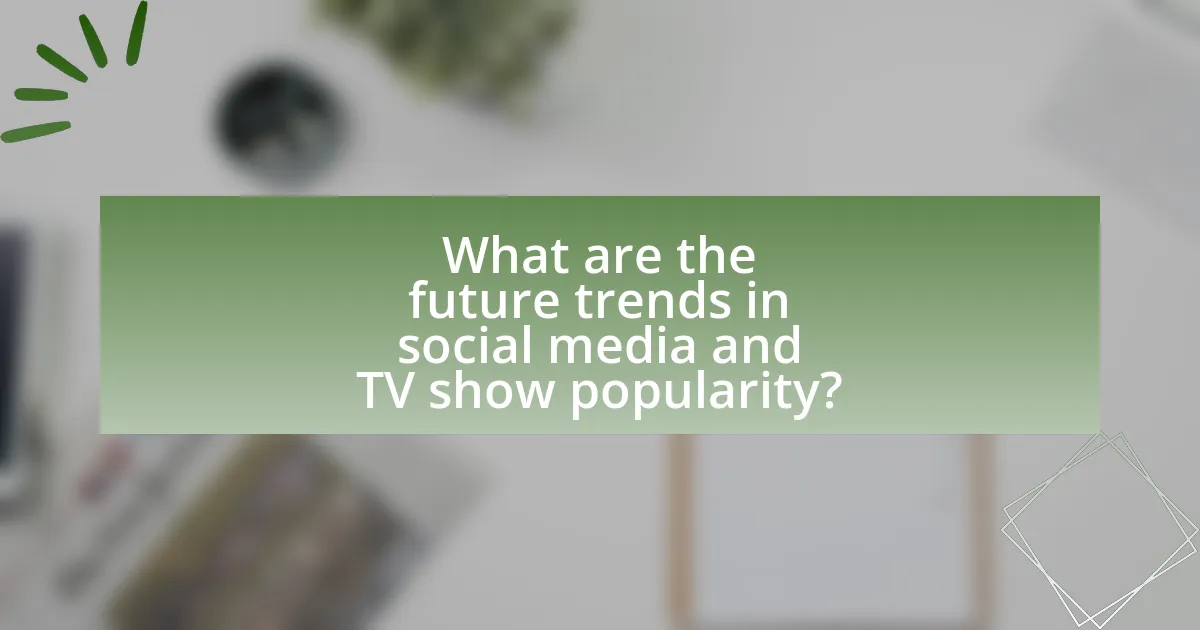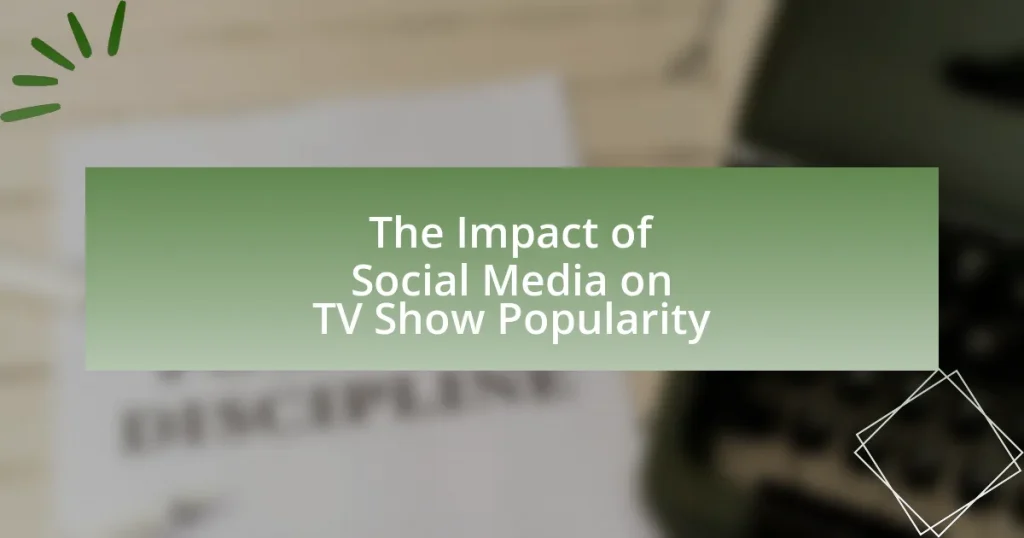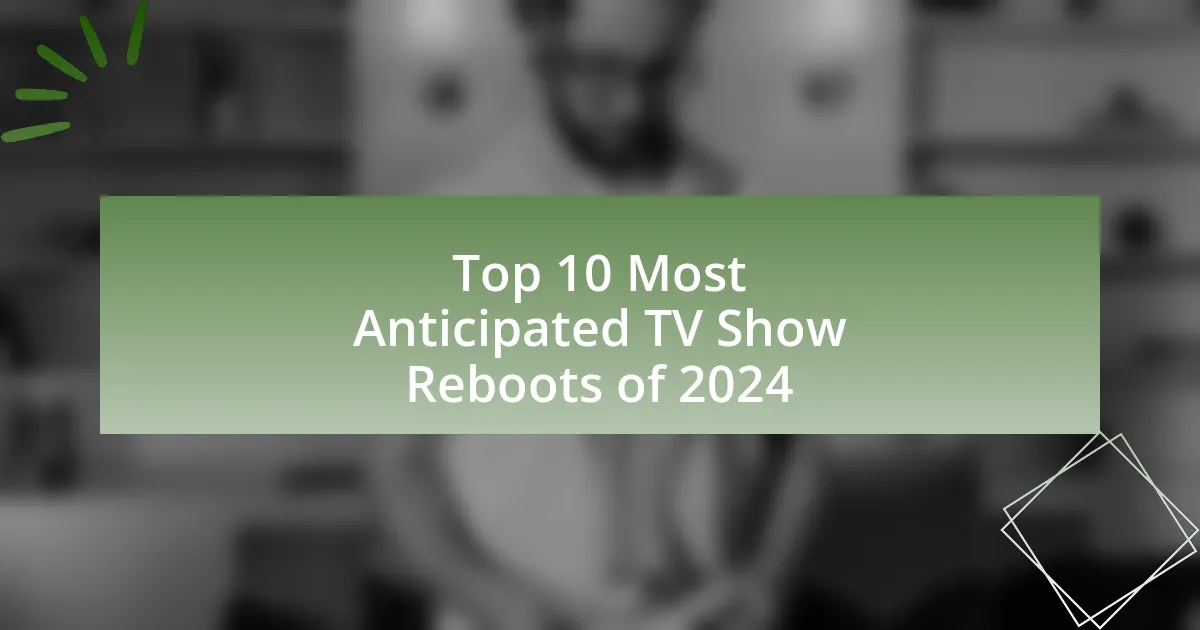The article examines the impact of social media on the popularity of TV shows, highlighting how platforms like Twitter, Instagram, and Facebook enhance audience engagement and visibility. It discusses the effectiveness of various social media platforms for promoting shows, the influence of viewer interactions on audience perception, and the critical role of fan engagement in driving viewership. Additionally, the article outlines strategies for effective social media marketing, the importance of audience feedback, and the challenges associated with relying on social media for success. Key metrics for measuring social media effectiveness and emerging trends in the landscape are also addressed, providing a comprehensive overview of how social media shapes TV show popularity.

What is the Impact of Social Media on TV Show Popularity?
Social media significantly enhances TV show popularity by facilitating audience engagement and increasing visibility. Platforms like Twitter, Instagram, and Facebook allow fans to discuss episodes in real-time, share content, and create buzz around shows, which can lead to higher viewership numbers. For instance, a study by Nielsen found that shows with active social media engagement saw a 20% increase in viewership compared to those with minimal online presence. Additionally, social media campaigns and influencer partnerships can amplify promotional efforts, reaching wider audiences and generating interest before a show’s premiere.
How does social media influence viewer engagement with TV shows?
Social media significantly enhances viewer engagement with TV shows by facilitating real-time interaction and community building among fans. Platforms like Twitter and Instagram allow viewers to share their thoughts, reactions, and fan theories instantly, creating a sense of belonging and shared experience. According to a study by Nielsen, 50% of social media users engage with TV shows while watching, indicating that social media acts as a companion medium that amplifies the viewing experience. Additionally, promotional content and behind-the-scenes access shared on social media can increase anticipation and excitement, further driving viewer engagement.
What platforms are most effective for promoting TV shows on social media?
The most effective platforms for promoting TV shows on social media are Facebook, Instagram, Twitter, and TikTok. Facebook allows for targeted advertising and community building through groups and pages, making it ideal for engaging with fans. Instagram’s visual focus enables creative promotional content, such as trailers and behind-the-scenes images, which can drive viewer interest. Twitter facilitates real-time engagement and conversation during live broadcasts, enhancing viewer interaction and buzz. TikTok’s short-form video format allows for viral marketing opportunities, particularly among younger audiences, making it a powerful tool for reaching new viewers. These platforms collectively leverage different strengths to maximize audience reach and engagement, as evidenced by successful campaigns from various TV networks that have utilized these channels effectively.
How do social media interactions affect audience perception of TV shows?
Social media interactions significantly shape audience perception of TV shows by facilitating real-time engagement and discussion among viewers. These platforms allow fans to share opinions, reactions, and critiques, which can influence the overall reception of a show. For instance, a study by the Pew Research Center found that 64% of social media users engage with content related to TV shows, indicating that online discussions can amplify positive or negative sentiments. Additionally, shows that generate high levels of social media buzz often see increased viewership, as evidenced by the success of series like “Stranger Things,” which gained popularity partly due to viral social media campaigns and fan interactions.
Why is social media a critical tool for TV show marketing?
Social media is a critical tool for TV show marketing because it enables direct engagement with audiences, fostering community and buzz around shows. Platforms like Twitter, Instagram, and Facebook allow networks to share trailers, behind-the-scenes content, and interactive posts that can reach millions instantly. For instance, a study by Nielsen found that 50% of viewers are more likely to watch a show if they see it promoted on social media. This engagement not only increases visibility but also encourages user-generated content, amplifying the show’s reach through shares and discussions.
What are the advantages of using social media for TV show promotion?
Using social media for TV show promotion offers several advantages, including increased audience engagement, cost-effectiveness, and real-time feedback. Social media platforms allow shows to interact directly with viewers, fostering a sense of community and loyalty. For instance, a study by Nielsen found that 50% of social media users engage with brands they follow, which can translate to higher viewership for promoted shows. Additionally, social media advertising is often less expensive than traditional advertising methods, allowing for broader reach with limited budgets. Furthermore, real-time feedback from audiences on platforms like Twitter can help producers gauge viewer reactions and adjust marketing strategies accordingly, enhancing overall promotional effectiveness.
How do social media campaigns differ from traditional marketing methods?
Social media campaigns differ from traditional marketing methods primarily in their interactivity and real-time engagement capabilities. While traditional marketing methods, such as print ads and television commercials, typically deliver one-way communication to a passive audience, social media campaigns allow for two-way interactions, enabling brands to engage directly with consumers, gather feedback, and foster community. For instance, a study by the Pew Research Center found that 69% of adults in the U.S. use social media, highlighting the platform’s extensive reach and potential for immediate consumer interaction compared to traditional media, which often lacks such immediacy and responsiveness.
What role does audience feedback play in shaping TV show popularity?
Audience feedback significantly influences TV show popularity by providing real-time insights into viewer preferences and engagement levels. This feedback, often gathered through social media platforms, ratings, and reviews, allows producers and networks to gauge audience reactions and adjust content accordingly. For instance, shows that receive high engagement on platforms like Twitter or Instagram often see increased viewership, as evidenced by the success of series like “Stranger Things,” which thrived on social media buzz. Additionally, audience feedback can lead to changes in storylines, character development, and marketing strategies, ultimately shaping the show’s trajectory and popularity in the competitive television landscape.
How do viewer comments and reviews on social media impact show ratings?
Viewer comments and reviews on social media significantly influence show ratings by shaping public perception and driving audience engagement. Positive comments can enhance a show’s reputation, leading to increased viewership, while negative reviews can deter potential viewers. For instance, a study by Nielsen found that 92% of consumers trust recommendations from friends and family over any other form of advertising, indicating that social media discussions can directly affect audience decisions. Additionally, platforms like Twitter and Facebook serve as real-time feedback channels, where trending topics and viewer sentiments can create buzz, further impacting ratings.
What is the significance of fan engagement in the success of a TV show?
Fan engagement is crucial for the success of a TV show as it directly influences viewership, ratings, and longevity. Engaged fans actively promote the show through social media, creating buzz and attracting new viewers; for instance, shows like “Stranger Things” have seen significant increases in viewership due to fan-driven campaigns and discussions on platforms like Twitter and Instagram. Additionally, a study by the University of Southern California found that shows with higher fan engagement on social media platforms tend to achieve better ratings and longer seasons, demonstrating a clear correlation between fan interaction and a show’s success.
How does social media create trends that affect TV show popularity?
Social media creates trends that significantly affect TV show popularity by facilitating rapid information sharing and audience engagement. Platforms like Twitter, Instagram, and TikTok allow users to discuss, share, and promote shows in real-time, leading to viral moments that can boost viewership. For instance, a study by Nielsen found that social media buzz can increase a show’s ratings by up to 20%, as viewers are influenced by trending topics and peer recommendations. Additionally, social media campaigns and influencer partnerships can create anticipation and excitement around new episodes or seasons, further driving audience interest and engagement.
What are the challenges of relying on social media for TV show success?
Relying on social media for TV show success presents several challenges, including fluctuating audience engagement and the potential for negative feedback to spread rapidly. Social media platforms often have algorithms that prioritize content based on user interaction, which can lead to inconsistent visibility for shows. For instance, a study by the Pew Research Center found that only 18% of social media users actively engage with content, meaning that a significant portion of potential viewers may not see promotional posts. Additionally, negative comments or reviews can quickly go viral, impacting public perception and viewership. This duality of engagement and backlash creates an unpredictable environment for TV shows that depend heavily on social media for marketing and audience connection.

What specific strategies can TV shows use on social media?
TV shows can utilize targeted engagement strategies on social media to enhance viewer interaction and increase popularity. These strategies include creating interactive content such as polls and quizzes that encourage audience participation, leveraging behind-the-scenes footage to build a connection with fans, and utilizing hashtags to facilitate discussions and trends related to the show. For instance, a study by the Pew Research Center found that 69% of adults in the U.S. use social media, indicating a significant platform for TV shows to reach and engage their audience effectively. Additionally, shows that actively respond to fan comments and create shareable content often see higher engagement rates, which can lead to increased viewership and loyalty.
How can TV shows effectively engage with their audience on social media?
TV shows can effectively engage with their audience on social media by creating interactive content that encourages viewer participation. This includes hosting live Q&A sessions, utilizing polls and quizzes, and sharing behind-the-scenes footage to foster a sense of community. For instance, shows like “The Bachelor” have successfully used Twitter to engage fans during episodes, resulting in increased viewer interaction and social media buzz. According to a study by Nielsen, 80% of social media users engage with TV-related content, highlighting the potential for shows to leverage these platforms for audience engagement.
What types of content resonate most with viewers on social media?
Visual content, particularly videos and images, resonates most with viewers on social media. According to a study by HubSpot, posts that include visuals receive 94% more views than those without. Additionally, engaging content such as memes, behind-the-scenes footage, and user-generated content fosters interaction and shares, enhancing viewer connection. Research from BuzzSumo indicates that videos are shared 1,200% more than text and links combined, highlighting their effectiveness in capturing audience attention.
How can TV shows leverage influencers to boost their popularity?
TV shows can leverage influencers to boost their popularity by collaborating with them to create engaging content that promotes the show to their followers. Influencers have established trust and a large audience on social media platforms, which can significantly increase visibility for the TV show. For instance, a study by Nielsen found that 92% of consumers trust recommendations from individuals over brands, highlighting the effectiveness of influencer marketing. By having influencers participate in promotional events, share behind-the-scenes content, or host watch parties, TV shows can tap into the influencers’ reach and credibility, driving audience engagement and viewership.
What metrics should be tracked to measure social media impact on TV shows?
To measure the social media impact on TV shows, key metrics include engagement rate, reach, sentiment analysis, and audience growth. Engagement rate quantifies interactions such as likes, shares, and comments relative to total followers, indicating viewer interest and involvement. Reach measures the total number of unique users who see the content, reflecting the show’s visibility. Sentiment analysis assesses the tone of social media conversations, providing insights into audience perceptions and reactions. Audience growth tracks the increase in followers or subscribers over time, indicating the show’s expanding fan base. These metrics collectively offer a comprehensive view of how social media influences TV show popularity.
How can engagement rates be analyzed to assess a show’s popularity?
Engagement rates can be analyzed to assess a show’s popularity by measuring interactions such as likes, shares, comments, and views across social media platforms. These metrics provide quantitative data reflecting audience interest and involvement, which are critical indicators of a show’s reach and resonance with viewers. For instance, a study by Nielsen found that shows with higher social media engagement often correlate with increased viewership ratings, demonstrating that active audience participation can enhance a show’s visibility and popularity.
What tools are available for measuring social media effectiveness in TV marketing?
Tools available for measuring social media effectiveness in TV marketing include social media analytics platforms, engagement tracking tools, and sentiment analysis software. Social media analytics platforms like Hootsuite and Sprout Social provide insights into audience engagement, reach, and demographics, allowing marketers to assess the impact of their campaigns. Engagement tracking tools, such as Google Analytics and Facebook Insights, measure interactions like shares, comments, and likes, which are crucial for understanding viewer response. Sentiment analysis software, such as Brandwatch and NetBase, evaluates public sentiment towards a TV show by analyzing social media conversations, providing a qualitative measure of effectiveness. These tools collectively enable marketers to quantify and analyze the influence of social media on TV show popularity.

What are the future trends in social media and TV show popularity?
Future trends in social media and TV show popularity indicate a growing integration of interactive content and real-time engagement. As platforms like TikTok and Instagram continue to evolve, they are increasingly influencing viewer preferences and shaping the success of TV shows through viral marketing and audience participation. For instance, a study by Nielsen in 2022 found that 70% of viewers engage with social media while watching TV, highlighting the importance of social media presence for shows to enhance viewer interaction and loyalty. Additionally, the rise of streaming services is leading to more personalized content recommendations driven by social media trends, further impacting TV show popularity.
How is the landscape of social media evolving for TV shows?
The landscape of social media for TV shows is evolving through increased interactivity and audience engagement. Platforms like Twitter, Instagram, and TikTok are now integral for real-time discussions, fan interactions, and promotional content, allowing shows to cultivate dedicated fanbases. For instance, a 2021 study by Nielsen found that 60% of viewers engage with social media while watching TV, indicating a significant shift towards a dual-screen experience. This evolution enhances viewer loyalty and drives ratings, as shows leverage social media for targeted marketing and audience feedback, ultimately shaping content and programming decisions.
What emerging platforms should TV shows consider for promotion?
TV shows should consider platforms like TikTok, Twitch, and Clubhouse for promotion. TikTok’s short-form video format allows for creative and viral content that can engage younger audiences, as evidenced by the platform’s rapid growth, reaching over 1 billion active users in 2021. Twitch offers live streaming opportunities for interactive fan engagement, with its user base exceeding 140 million monthly active users, making it ideal for real-time promotions and community building. Clubhouse provides an audio-based social networking experience, enabling discussions and behind-the-scenes insights that can deepen viewer connection, with its user base growing significantly since its launch in 2020. These platforms are increasingly influential in shaping viewer preferences and can enhance the visibility of TV shows.
How might changes in social media algorithms affect TV show visibility?
Changes in social media algorithms can significantly affect TV show visibility by altering how content is prioritized and distributed to users. For instance, if an algorithm favors video content over static posts, TV shows that produce engaging video clips may gain more visibility, leading to increased audience engagement. Conversely, if an algorithm limits organic reach for promotional posts, even popular shows may struggle to reach their audience, resulting in decreased visibility. Research indicates that platforms like Facebook and Instagram have shifted their algorithms to prioritize user engagement metrics, which directly impacts how often TV shows appear in users’ feeds, thus influencing their overall popularity and viewership.
What best practices should TV shows follow for social media engagement?
TV shows should prioritize authentic interaction with their audience for effective social media engagement. Engaging directly with fans through comments, polls, and live Q&A sessions fosters a sense of community and loyalty. Research indicates that shows with high levels of audience interaction see a 30% increase in viewer retention rates, demonstrating the importance of active engagement. Additionally, utilizing multimedia content, such as behind-the-scenes footage and interactive stories, can enhance viewer interest and participation, further solidifying the show’s presence on social media platforms.
How can consistency in posting improve audience retention?
Consistency in posting enhances audience retention by establishing a reliable schedule that audiences can anticipate. When content is regularly shared, viewers develop a habit of engaging with the material, leading to increased loyalty and sustained interest. Research indicates that brands that post consistently can see up to a 67% increase in audience engagement, as regular updates keep the audience informed and connected. This predictable rhythm fosters a sense of community and belonging among viewers, which is crucial for maintaining their attention over time.
What are the common pitfalls to avoid in social media marketing for TV shows?
Common pitfalls to avoid in social media marketing for TV shows include inconsistent branding, neglecting audience engagement, and failing to analyze performance metrics. Inconsistent branding can confuse viewers and dilute the show’s identity, as seen with shows that change their messaging or visual style across platforms. Neglecting audience engagement leads to missed opportunities for building a loyal fan base; research indicates that shows with active interactions on social media see higher viewer retention rates. Lastly, failing to analyze performance metrics prevents marketers from understanding what content resonates with audiences, which can result in ineffective campaigns.




